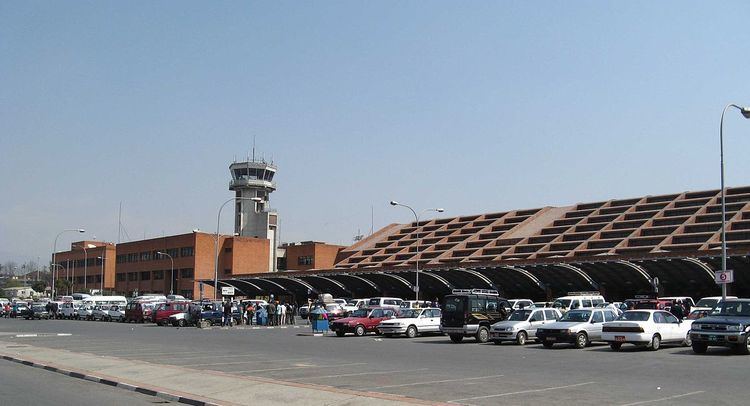Airport type Public Elevation AMSL 4,390 ft / 1,338 m Code KTM Phone +977 1-4113033 | Website www.tiairport.com.np Elevation 1,338 m Number of runways 1 | |
 | ||
Hub for Buddha AirHimalaya AirlinesNepal AirlinesSaurya AirlinesSimrik AirlinesSita AirTara AirYeti Airlines Address Ring Rd, Kathmandu 44600, Nepal Profiles | ||
Tribhuvan International Airport (Nepali: त्रिभुवन अन्तर्राष्ट्रिय विमानस्थल, IATA: KTM, ICAO: VNKT) is an international airport in Kathmandu, Nepal. The airport is about six kilometres from the city centre, in the Kathmandu valley. It is the sole international airport in Nepal, though Nijgadh International Airport has been proposed as a second. The airport has served as an airfield since 1949, and was inaugurated in 1955 by King Mahendra. It received its current name in 1964. Originally a grass runway, it was re-laid in concrete in 1957 and has been extended several times. The first jet aircraft landed at Tribhuvan in 1967 and regular jet operations commenced in 1972.
Contents
- Airport of nepal tribhuvan international airport view
- History
- Facilities
- Ground transportation
- Incidents and accidents
- References
The airport has one domestic and one international terminal. In 2015, the airport handled 3.21 million passengers, down 8.37% from 2014. At present, about 30 international airlines connect Nepal to destinations in Asia and the Middle East, and the airport serves as a hub for several Nepalese airlines.
Airport of nepal tribhuvan international airport view
History
The airport was originally named Gauchaur Airport, after the area of Kathmandu where it was situated. The formal beginning of aviation in Nepal occurred in 1949, with the landing of a Beechcraft Bonanza aircraft, carrying the Indian ambassador. The first charter flight took place between Gauchaur and Calcutta, in a Himalayan Aviation Dakota on 20 February 1950.
In 1955 the airport was inaugurated by King Mahendra and renamed Tribhuvan Airport in memory of the king's father. The airport was again renamed Tribhuvan International Airport in 1964. The original grass runway was re-laid in concrete in 1957 and extended from 3,750 feet (1,140 m), to 6,600 feet (2,000 m) in 1967. The runway was again extended from 6,600 feet (2,000 m) to 10,000 feet (3,000 m) in 1975.
The first jet aircraft to land at Tribhuvan was a Lufthansa Boeing 707 in 1967. Royal Nepal Airlines Corporation commenced jet operations at the airport in 1972 with Boeing 727 aircraft.
In May 2007, Austrian Airlines discontinued their flight to Vienna, which severed Nepal's direct air links with Europe. Since September 2013, Turkish Airlines launched direct flights from Istanbul to Kathmandu, re-establishing Nepal's connection with continental Europe.
Facilities
The airport has a single 10,007 feet (3,050 m) concrete runway orientated 02/20. There is no instrument landing system available. The airport has two public terminals—one for international and one for domestic traffic. It also has a terminal for VIP guests. There are some tea shops outside the airport. There are few ATMs for drawing money.
Radisson Hotel Kathmandu operates an executive lounge for first and business class passengers for some airlines and Thai Airways International operates a business lounge for its business-class passengers, as well as Star Alliance Gold card holders.
Ground transportation
Sajha Yatayat buses connect the airport to city centre, with the last around 18:00. Meter and pre paid taxis are available at both terminals at all hours.
